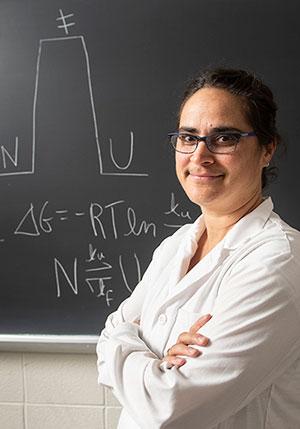
For decades, colleges and universities have attempted, largely unsuccessfully, to recruit and retain greater numbers of women and underrepresented people of color in the STEM fields (science, technology, engineering and math). This lack of diversity in STEM is something that Sheila Jaswal—herself a biracial, LGBT chemistry professor at Amherst—has observed firsthand over her three decades of taking and then teaching STEM courses.
But Jaswal began to look at the problem differently in November 2015 while listening to students involved in the Amherst Uprising sit-in share their own powerful stories of feeling marginalized on campus and beyond.
“My colleagues and I have a deep commitment to student success, and are genuinely distressed that students experience the struggles they do,” Jaswal says. “So how can we and other people in our community bridge this disconnect? Especially we STEM professors, who have been trained in disciplines that view STEM as objective and color-blind, even as we bemoan the continued underrepresentation of folks at every stage of the so-called pipeline?”
Jaswal decided to take a more academic approach to answering those questions. In the spring of 2016, she and nine students collaboratively developed the “Being Human in STEM” course, or HSTEM, which is devoted to exploring why the lack of diversity in STEM persists in the U.S. and what steps can be taken at Amherst to combat it.
Participants in the class first investigate the “lived Amherst experience” of marginalized students through interviews they conduct as they read the research literature on diversity and inclusion in STEM. After compiling their findings, Jaswal and the HSTEM students then collaborate with Megan Lyster, instructional designer in experiential learning at the Center for Community Engagement, to develop various STEM-related projects.
Over the five semesters the HSTEM course has been offered, the results of the research portion have been fairly uniform, says Jaswal: Students feel validated when they hear about experiences they share with classmates; learn about academic concepts such as stereotype threat and imposter syndrome; and analyze data on representation, success and persistence. They feel included and proud when leading and contributing to STEM-related conversations and projects.
Such responses serve as the foundation of the projects the students produce for the class. Previous projects have included guides for conducting workshops on diversity with STEM students and inclusive activities with children; a handbook on inclusive curricular practices; a documentary about HSTEM; and a website and detailed curriculum for a summer HSTEM course for students involved with the College’s Summer Undergraduate Research Fellowship program.
For Dawit Wachelo ’20, talking to fellow students was the most enlightening and rewarding experience of taking the course this summer. “I realized that I had taken diversity for granted upon listening to [the students talk about the] various obvious and often subtle benefits of diversity,” he explains. “I could also feel the intensity and nature, whether delightful or hurtful, instructive or destructive, of their experiences.”
In addition to the 50-plus students majoring in more than 20 disciplines who have taken the HSTEM class since its creation, nearly 200 faculty, staff and other students have joined the conversation by participating in a workshop or interview or attending an end-of-semester open house with project presentations. Several campus organizations have stepped up to support it, including the Dean of Faculty and Diversity and Inclusion offices, Keefe Science Library, Department of Chemistry and the centers for Community Engagement, Teaching and Learning and Humanistic Inquiry.
Word of the initiative is spreading. Some of the projects—such as the handbook on inclusive curricular practices—are being used at other institutions in addition to Amherst. The HSTEM model has been adopted by Yale and Brown universities, with courses planned at Skidmore and Mount Holyoke colleges. And 75 individuals from 10 institutions attended an HSTEM summit at Yale in April.
The next step will be to assess the impact of HSTEM practices, the course itself and whether the numbers of students persisting in STEM have increased as a result, said Jaswal.
Regardless of what the numbers show, Jaswal is heartened by anecdotal evidence that HSTEM is working at Amherst and the other colleges and universities that have embraced it. “The collaborative HSTEM course model can be adapted to investigate and address issues of inclusion at any institution, because it means simply listening to and including diverse humans,” she says. “Empowering students to investigate issues of inclusion instills a sense of shared responsibility for designing interventions that will work in their own STEM communities and beyond.”
